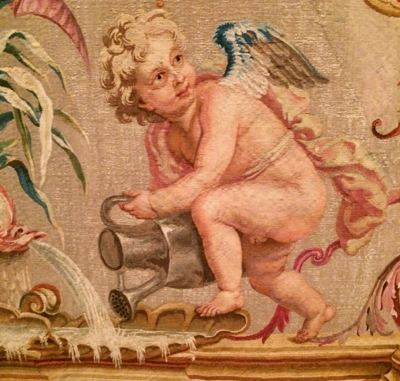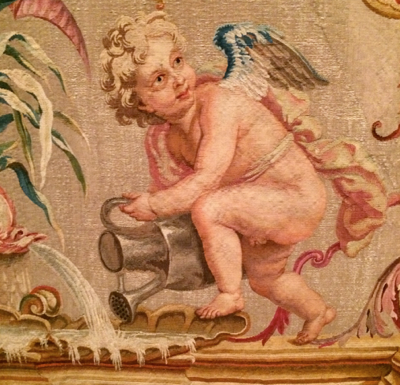
Gardeners of Britain your show of the year has opened at the Queen’s Gallery. The story of the garden in art, Painting Paradise is full of views, botanical prints and paintings of regal gardens. Whilst demonstrating the depth of the royal collection this large show explores how the garden inspired artists and craftsmen between 1500 and early 20th century.

A View of Hampton Court c. 1702-14 Leonard Knyff
Gardens as a man-made construct, an enclosed space of controlled nature, are first seen in Persia. These early examples of aesthetic cultivation are represented by the painted miniature Seven Couples in a Garden, c.1510, from the earliest illustrated Islamic manuscript in the Royal Collection. This shows the first attempt at an earthly paradise that subsequent gardeners try to achieve throughout the rest of the show.
Big names have been brought out to play. Jan Brueghel the Elder and Fabergé are represented, as is Leonardo who contributes some small botanical studies. A Rembrandt of Christ and Mary Magdalene at the tomb, is peculiar. He makes Mary’s mistaken belief that Jesus is the gardener bizarrely believable by presenting Jesus in gardener’s garb, carrying tools.
One unexpected highlight is what must be the earliest example of the watering can in art. Made of woven silk and wool, this tapestry would have been a portiere, or door curtain, keeping out draughts and reminding of the summer to come.

Gobelins Tapestry/G Neilson (detail) c1768
As in most things fashions change and this exhibition does a fine job of showing the way the idea of the perfect garden has changed over time. Gardens are shown to have been used as statements of power and status, as well as private expressions of love and family life. Wife-killer Henry VIII first used the garden for propaganda, using it as a means to express power over his rivals and the show includes the work The Family of Henry VIII, which shows Great Garden at Whitehall Palace and is the first time a real garden appears in British art.
War by other means took place in garden design in the 16th century, when royal garden rivalry reached its zenith. Nations indulged in horticultural combat, with great kudos heading to Holland who managed to fruit the pineapple before France. French and English kings competed to produce increasingly large and elaborate horticultural creations. The exhibition shows Louis XIV’s gardens at Versailles in a panoramic view by Jean-Baptiste Martin, and William III’s impressive gardens at Hampton Court by Leonard Knyff. Two of the sun dials that can be seen (by the eagle-eyed) in this painting are on display in the same room.
The introduction of flowers to gardens happens late, in the 19th century. In keeping with the Victorian love of euphemism, a complicated language of flowers quickly grew up, with different flowers embodying different feelings and ideas. These are demonstrated in the show, but are further revealed in the learning room outside the exhibition. The Queen’s gallery always puts on a fun interactive learning room. No doubt ostensibly for kids the various examples of scents to sniff are overpowering. It also includes more details about the language of flowers, so the next time someone gives you a bouquet you know what they mean – assuming the flowers weren’t just the only ones left at the garage.
Like gardens? You’ll love Painting Paradise
Until the 11th October

Leave a Reply